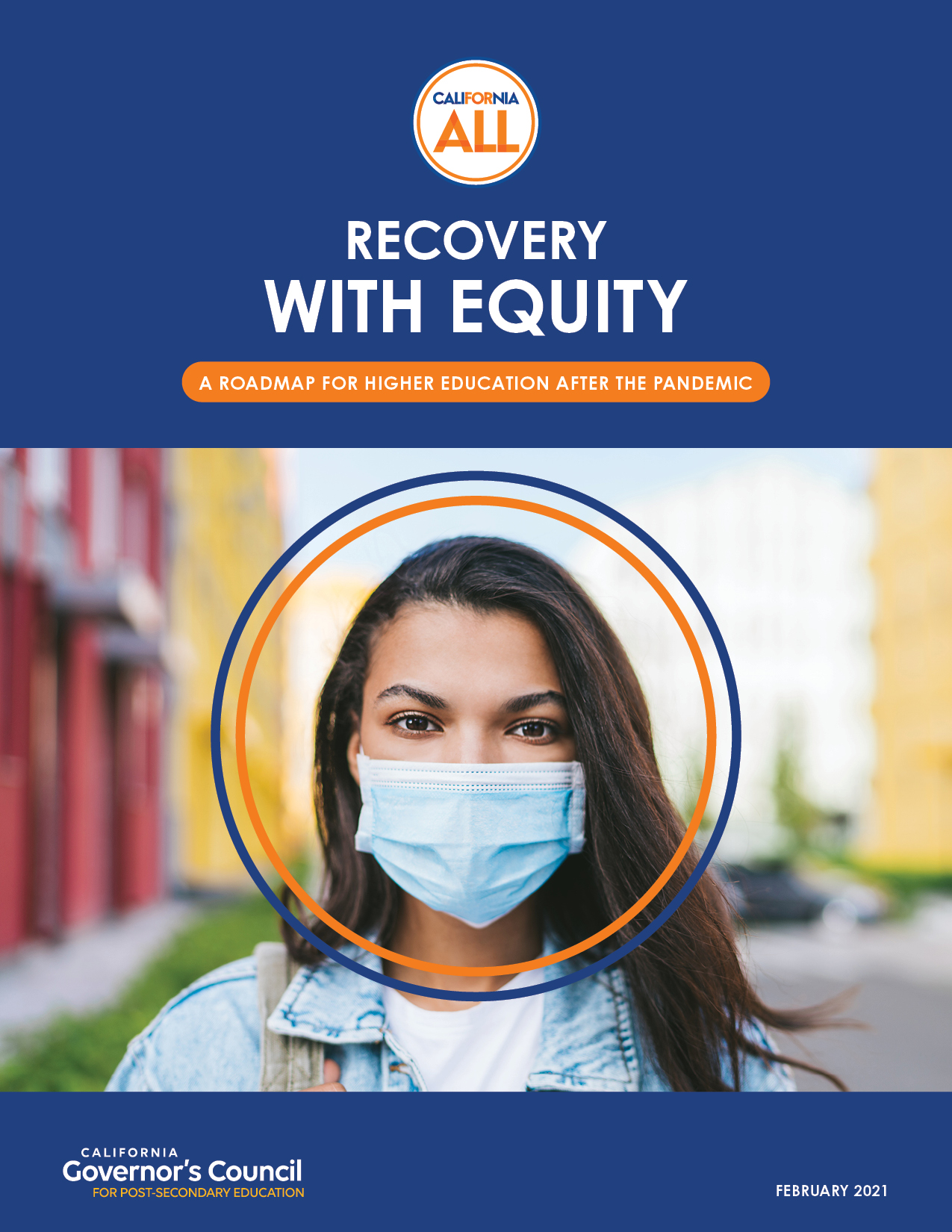Recommendations for Policy and Practice
The Recovery with Equity Taskforce developed recommendations to help post-secondary systems emerge from the pandemic stronger and better able to help all learners thrive. This set of interconnected, interdependent systemic solutions is meant to fundamentally change the way California supports all of its residents in equitably preparing for and engaging in education and careers.
Fostering Inclusive Institutions
Goal: By 2030, learners of all backgrounds will report that they feel valued, supported, and affirmed at their institutions; that faculty are adept at creating courses that are responsive to and build upon the unique experiences, needs, and talents of all learners; and that post-secondary institutions actively support their academic success and career readiness.
1. Improve Faculty, Staff, and Administrator Diversity
An equitable and inclusive culture cannot occur if campus personnel do not reflect the rich diversity of California. Expanding faculty, staff, and administrator diversity requires dedicated, intentional efforts bolstered by strong data monitoring and accountability.
2. Cultivate Inclusive, Engaging, and Equity-Oriented Learning Environments
System and local boards, faculty, administrators, and staff need professional development, resources, and support to redesign the learning environment so that it better serves all learners.
3. Retain Students through Inclusive Supports
To develop an affirming and supportive culture that promotes student wellbeing and academic success, institutions must intentionally, thoughtfully, and creatively evaluate and, as necessary, redesign current support activities and develop new practices and programs.
Streamlining Pathways to Degrees
Goal: By 2030, learners will have clear, easy-to-navigate pathways into and through post-secondary education, as well as admission and transfer processes facilitated by an integrated technology platform, dual admission, and common course numbering.
4. Establish an Integrated Admissions Platform
California should create a single technology platform for admissions and transfer to replace the currently overwhelming and byzantine application and transfer processes. Designed well, such a platform also can help colleges and universities better manage enrollment, integrate recognition of students’ existing knowledge and skills through credit for prior learning and mastery-based learning, plan for course delivery, and address capacity constraints.
5. Streamline and Unify the College Admission Process
Recognizing that most learners attend more than one college in order to earn a degree, California public institutions should adopt a streamlined and unified admission process, enabled by an integrated technology platform, that provides an option for dual admission to smooth the pathway for learners who wish to attend a four-year institution but begin at a community college.
6. Develop a Common Course Numbering System
To streamline transfer from two- to four-year institutions and reduce excess credit accumulation, California’s community colleges should adopt a common course numbering system, starting with general education requirements, and eventually expanding to transfer pathway courses. The aim would be to align all community college courses so that students transferring to four-year institutions know, as they are pursuing their courses, that they are meeting the requirements of the receiving institutions.
Facilitating Student Transitions
Goal: By 2030, learners in all public schools will have access to college preparatory coursework; early college experiences; and a high-tech, high-touch advising system that supports their success from middle and high school into and through higher education and into the workforce.
7. Provide High-Tech, High-Touch Advising
Through an integrated technology platform paired with a statewide chatbot, California can ensure that middle school, high school, and college learners (and those who support them) can access all the information they need regarding learners’ educational records, college preparation, enrollment, financial aid, and progress toward a degree. The technology platform and chatbot should integrate tools to allow advisors to provide data-driven, high-tech, high-touch advising to support learners on their pathways to degrees.
8. Support College Preparation and Early Credit
Completing a college preparatory curriculum is important to high school learners’ ability to transition and succeed in post-secondary education. A–G course completion sets learners up to be eligible for admission to CSU and UC, and earning early college credit—for example, through dual enrollment—not only gives learners credit toward a post-secondary degree but also can instill confidence in their ability to be successful in college. K–12 and post-secondary education should work together to make A–G coursework the default high school curriculum, strengthen K–12 accountability for college preparation, and expand access to early college experiences.
Simplifying Supports for Student Stability
Goal: By 2030, learners will receive support to meet basic needs through a simplified, integrated system that enables qualified college students to access California’s social services, subsidized internet and technology, and increased financial aid.
9. Integrate Platform of State Services for Students
California should build an integrated platform that allows learners to apply all at once for the full spectrum of state services they qualify to receive (e.g., financial aid, CalFresh, housing programs, health/mental healthcare, subsidized childcare, transportation, internet/technology support, etc.). The system also would provide all students, families, and advisors with a simplified, low-burden approach to completing the FAFSA and the California Dream Act Application (CADAA) prior to high school graduation and return timely information to support their next steps. When combined with a unified college application process, this system can become a powerful one-stop shop for post-secondary learners, families, and advisors.
10. Subsidize Internet Access for Eligible Students
California should provide students who need it with subsidized access to reliable internet service by expanding the amount of funds offered through Cal Grant B and forming public-private partnerships to offer support for internet and technology access to all students who qualify. This strategy builds on the significant effort begun early in the pandemic to expand technology access, and on recommendations of the California Broadband for All report issued in late 2020.
11. Improve College Affordability
California would benefit from increasing and diversifying opportunities for financial aid, as well as providing students with paid work opportunities (including federal work study) that prepare them for careers without getting in the way of their academic progress. Finally, California must create a pathway whereby learners can complete post-secondary education without having to take on additional debt, through a combination of refocusing and increasing student financial aid.
GET THE DETAILS
For specific changes to policy and practice, resources needed, and next steps for these recommendations, read the full Recovery with Equity report.
GET INVOLVED
This work takes collaboration across segments and sectors: Contact us to share your feedback, questions, and ideas.


The Governor’s Council for Career Education is working to empower all Californians – youth and adult learners alike – to discover, prepare for, and connect to careers.


